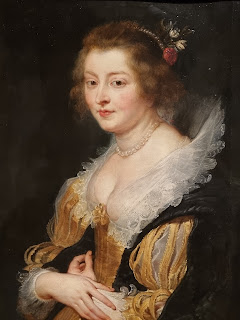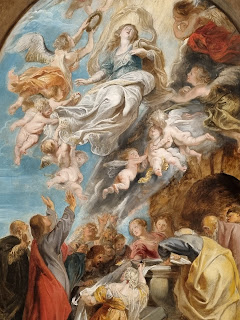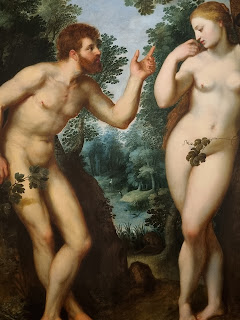Rubenesque! Is it possible that Peter Paul Rubens is the only artist in history whose name has been converted into an adjective to describe a certain type of woman? Probably not - but he's the only one I can think of right now. The dictionary describes rubenesque as "suggestive of the painter Rubens or his works, plump or rounded usually in a pleasing way".

Three Nymphs with a Cornucopia (c.1625-1628)
Phwoar! A typical example would be Three Nymphs with a Cornucopia in which we can see Ceres, goddess of abundance (what else?) holding a horn of plenty overflowing with fruit over the head of another (unnamed) nymph while yet another (also unnamed) nymph looks on. Nymph, for the record, doesn't mean nymphomaniac. It means "a mythological spirit of nature imagined as a beautiful maiden inhabiting rivers, woods, or other locations".
So, yes, it's undeniable that Rubens did, indeed, paint lots of women who would qualify for the adjective rubenesque. But, as the Dulwich Picture Gallery seem to be trying to say in their current exhibition Rubens & Women, that's not the entirety of Rubens' art when it comes to depictions of what people once condescendingly described as "the fairer sex".
Rubens, we're told, was considered the greatest living artist of his time (though the likes of Rembrandt, Poussin, Caravaggio, and Velazquez may have had something to say about that) and he was knighted by the kings of both England (Charles I) and Spain (Philip IV). Portraiture wasn't his great passion (he had ambitions to paint great mythological and historical scenes) but it was what he excelled at and he discovered, early in his career, that it opened doors for him.
In 1600, at the age of 22, he left Antwerp for Italy where he stayed, under the employment of Vincenzo I Gonzaga, Duke of Mantua, for eight years. During that time he travelled to Venice, Florence, Rome, and Genoa as well as to Spain where he cemented his relationship with wealthy and powerful patrons by creating dazzling portraits that flattered and wowed them.
But the exhibition begins with a more personal side of Rubens' work and, for me, it's all the more impressive because you get the feeling that Rubens isn't trying to impress very important, and very rich, people but is, instead, simply painting the people he loved - and painting them with love. Already a well established, and hugely successful, artist he said, at the age of 57:- "now by God's grace .... I am leading a quiet life with my wife and children and have no pretensions in the world than to live in peace".
Isabella Brant (c.1626)
I love the painting of his wife, Isballa Brant, because it has such a human quality. She's got a cheeky smile that seems to reflect an insouciant manner and suggests a relaxed, easy, loving relationship between her and Rubens. The best couples always make each other laugh and they always notice small, endearing, peculiarities about each other.
Of course this is pure speculation on my behalf but that's how the painting makes me feel and art is about nothing if it is not about interpretation. Beyond doubt, however, is that Brant died, aged 34, in 1626 - the year the painting is believed to have been made. So it is likely it was painted in the heights of grief and at a time when Rubens was beside himself. He claimed he would love her forever and the vine growing on the pillar in the background is believed to be his way of showing that though death is final, love is too - and love is stronger.
It had not been the first tragedy in Rubens' life. His daughter, with Isabella Brant, Clara Serena, had died three years before her mother - aged just twelve. She had been named Clara for her sparkling brightness and Serena for her tranquility. It's hard to imagine how painful it must be for anyone to lose a child - especially one as young as Clara Serena.
Portrait of Clara Serena Rubens (c.1620-1623)
Isabel Clara Eugenia, Infanta of Spain, in the Habit of a Poor Clare (1625)
These personal, mournful even, family portraits are more intimate and meaningful than the works that Rubens was more celebrated for at the time. Paintings of the likes of the Infanta of Spain (Rubens had been appointed court painter to Archdukes Albert and Isabel who ruled the Southern Netherlands on behalf of the Spanish king) and Marchesa Maria Serra Pallavicino (believed to be made because Rubens' boss, the Duke of Mantua, was in debt to the Pallavicino banking family) are technically impressive but the sitters pose performatively. The Infanta wants us to see how holy she is, how she suffers for her religion, and Pallavicino, it seems, is interested only in flaunting her wealth. Rubens allowed both to do so. It's a living.
Marchesa Maria Serra Pallavicino (1606)
Portrait of a Young Woman Holding a Chain (c.1603-1606)
Portrait of a Woman (c.1625-1630)
Working in the era he was, and in the countries he was, it was inevitable that religion, specifically Catholicism, would become a prominent part of his work. He was commissioned to create images that aided worship and promoted the Counter-Reformation. These came in the form of altarpieces and epic decoration of churches and in order to connect with the faithful, Rubens included realistic looking people, realistic looking women, and then converted them into religious figures.
A confident man, success breeds confidence in some, Rubens stated that "no undertaking, however vast in size or diversified in subject" had ever defeated his "courage" which is nice and modest of him. He did, however, also make small paintings that were to be used for private devotion suggesting he wasn't ALL bluster. Even if there was a lot of bluster.
As is normal with religion, especially Christianity (though Judaism and Islam are just as bad - look at all those religious psychopaths murdering each other in Gaza right now), many of the scenes that are supposed to be inspirational are actually horrific. Here's Saint Barbara's father trying to kill her with a sword and then being struck down by lightning (that one went on the ceiling of a Jesuit church in Antwerp which was itself destroyed by fire - perhaps God disapproved) and here's the Virgin Mary and young Jesus on their flight into Egypt to escape being killed by Herod.
Saint Barbara Fleeing from Her Father (c.1620)
Modello for the Ascension of the Virgin (c.1622-1625)
The Flight into Egypt (1614)
I'm not knocking the paintings (they're great) but why is it that Christianity and the other Abrahamic faiths are so obsessed with stories about killing children and why is it that so many are shocked that a war happening right now in the birth place of all these faiths, and between proponents of these faiths, has carried on this rich lineage of infanticide?
To me, infanticide is baked in to these religions. Read the bible, read the Torah, and look at these Rubens paintings and the stories they tell and tell me they're not. And yet the person we're supposed to feel infinite, and unending, sympathy for is the stricken Christ (below). The person most responsible for spreading this evil belief system.
Hagar in the Desert (c.1630s)
I have a lot more sympathy for Hagar, the Egyptian maidservant who was banished to the desert for becoming pregnant (yet another example of religious misogyny and hypocrisy) where she is visited by an angel. Probably hallucinating to be fair.
But, before I go off on another anti-Christian rant, it's worth considering that Hagar, in this portrait, is supposed to resemble Rubens' second (and, the exhibition makes a prurient point of telling us, much younger) wife Helene Fourment whom he married in 1630. It wasn't uncommon for Rubens to use his wives and other family members as inspiration for his religious paintings. The Virgin in Adoration, from over ten years earlier, is said to resemble Isabella Brant (you can check for yourself using this blog), while the Christ Child, in the same painting, is thought to be modelled on one of his sons, either Albert or Nicolaas.
The Virgin in Adoration before the Christ Child (c.1616-1619)
Head of a Woman Looking Downward (c.1630-1631)
Of course, if you were a male painter, almost during any period of history, and you painted women often it is almost inevitable that, eventually, you'll get round to painting them
without their clothes. Rubens was no exception and he looked to the Renaissance superstar
Michelangelo and even further back to ancient art for guidance in this field.
Interestingly, Rubens would sometimes use male models to help refine and perfect the poses he wanted as images of females to take on. More contentiously, the curators claim that Rubens' women were no more "voluptuous" than those painted by his predecessors and that they were "simply more life-like" and that their skin was "convincingly elastic and believably warm". Before rubbing their hands up and down their trousers and gurning lecherously.
Night (after Michelangelo) (c.1600-1603)
Venus Nursing Cupids ('Crescetis Amores') (1616)
Study of a Seated Woman, Turned to the Right (c.1633-1635)
Adam and Eve (c.1599)
Night features a marble figure from the tomb of Giuliano de Medici in Florence, Venus nursing Cupids does what it says - it shows Cupid and his putti chums suckling on Venus' breast(s), the Seated Woman may well be another portrait of Helene Fourment - this time undressing, and Adam and Eve (believed to be painted in or around 1599) may well be the earliest surviving large scale nude painting that Ruben made. Would you Adam and Eve it?
In fact, this work was made before Rubens' women became "voluptuous", before they became "rubenesque". It's said to be inspired by Raphael. The fully rubenesque can be witnessed on works like Venus Mourning Adonis (Adonis has been fatally wounded out hunting and Venus is cradling him), The Birth of Venus (a silverware design for a basin, bring it on), and The Three Graces.
Venus Mourning Adonis (c.1613-1615)
The Birth of Venus (c.1632-1633)
The Three Graces (c.1636)
None of these works are very colourful but the final room of the exhibition, Goddesses of Peace and Plenty, erupts in a riot of colour. It's a good way to end the show. These are dramatic paintings and they manage to combine Rubens' skill as a portrait painter with his ambition to paint mythological/historical scenes.
Inspired by Titian's Renaissance painting and the stories of the Roman poet Ovid (43BC - AD17/18) and made at a time when his homeland of the Netherlands was involved in the Eighty Years War with the Spanish Republic, they are seen as a call to peace with the women in the paintings acting, as women so often do, as the agents of peace.
Rubens combined his work as an artist with that as a diplomat and would travel across Europe undertaking peace negotiations on behalf of the Archduchess Isabel Clara Eugenia (her in the nun's habit, earlier on). These paintings are perhaps the best example of Rubens combining his art and his diplomatic endeavours.
There's a couple of collaborations with the still life painter Frans Snyders (Rubens obviously couldn't be bothered to waste time on fruit and all that boring stuff) including a more fleshed out, more electric, Three Nymphs with a Cornucopia. This one was taken to Spain and offered as a token in a bid to broker peace between England and Spain.
There's Juno, the queen of the goddesses, being tricked by Jupiter into nourishing the infant Hercules and on realising that then refusing him her breast milk and squirting it into the sky to create the Milky Way (hmmm!) and then there's Venus, Mars, and Cupid. A painting in which the goddess of love (Venus) sits down with the god of war (Mars) and the child (Cupid) that they have had, somewhat surprisingly consider their differences, together.
Venus is feeding Cupid but Mars, of course, is eager to get back to war. However, a little putto has loosened Mars's armour and when he stands up his breastplate will fall to the floor. For some reason, he's unable to put it back on and then is unable to return to war and Venus, and love, has won.
These Christian, and other mythological stories, are, of course, ridiculous and, most likely, they're intended as allegories rather than as truthful fables but the message in that one, that love most always conquer the day, is a good one - and Rubens' paintings, be they muted, be they colourful, be they commissions taken by the high and mighty, or be they deep and meaningful personal meditations on those he loved and cared about are very good too. Rubenesque? This exhibition definitely was.
Rubens and Frans Snyders - Diana Returning from the Hunt (c.1623)
The Birth of the Milky Way (1636-1638)
Venus, Mars and Cupid (c.1635)
Rubens and Frans Snyders - Three Nymphs with a Cornucopia (c.1625-1628)

Self-portrait (1604-1605)





























No comments:
Post a Comment